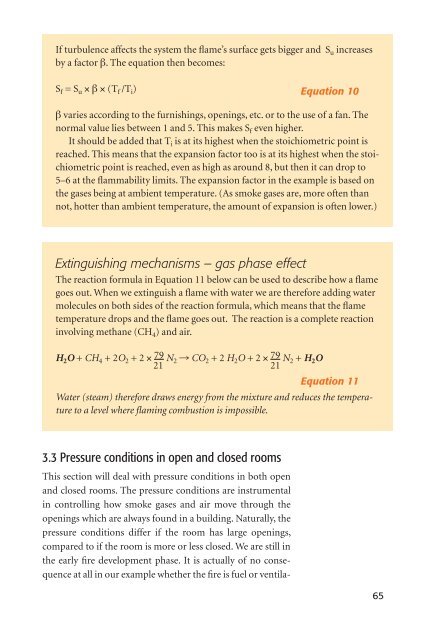You also want an ePaper? Increase the reach of your titles
YUMPU automatically turns print PDFs into web optimized ePapers that Google loves.
If turbulence affects the system the fl ame’s surface gets bigger and S u increases<br />
by a factor b. The equation then becomes:<br />
S f = S u × b × (T f /T i)<br />
3.3 Pressure conditions in open and closed rooms<br />
This section will deal with pressure conditions in both open<br />
and closed rooms. The pressure conditions are instrumental<br />
in controlling how smoke gases and air move through the<br />
openings which are always found in a building. Naturally, the<br />
pressure conditions differ if the room has large openings,<br />
compared to if the room is more or less closed. We are still in<br />
the early fi re development phase. It is actually of no consequence<br />
at all in our example whether the fi re is fuel or ventila-<br />
Equation 10<br />
b varies according to the furnishings, openings, etc. or to the use of a fan. The<br />
normal value lies between 1 and 5. This makes S f even higher.<br />
It should be added that T i is at its highest when the stoichiometric point is<br />
reached. This means that the expansion factor too is at its highest when the stoichiometric<br />
point is reached, even as high as around 8, but then it can drop to<br />
5–6 at the fl ammability limits. The expansion factor in the example is based on<br />
the gases being at ambient temperature. (As smoke gases are, more often than<br />
not, hotter than ambient temperature, the amount of expansion is often lower.)<br />
Extinguishing mechanisms – gas phase effect<br />
The reaction formula in Equation 11 below can be used to describe how a fl ame<br />
goes out. When we extinguish a fl ame with water we are therefore adding water<br />
molecules on both sides of the reaction formula, which means that the fl ame<br />
temperature drops and the fl ame goes out. The reaction is a complete reaction<br />
involving methane (CH 4) and air.<br />
H2O + CH4 + 2O2 + 2 × 79 N2 P CO2 + 2 H2O + 2 × 79 N2 + H2O 21<br />
21<br />
Equation 11<br />
Water (steam) therefore draws energy from the mixture and reduces the temperature<br />
to a level where fl aming combustion is impossible.<br />
65

















